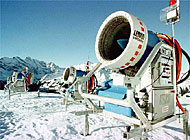Snow cannons draw fire from environmentalists

Many of Switzerland's ski resorts rely on artificial snow to keep skiers happy when the weather fails to deliver. But environmentalists fear that snow cannons are damaging the fragile alpine landscape.
The battle over snow cannons is nowhere more fierce than in canton Valais, which is home to world famous ski resorts like Zermatt, Saas Fee, Verbier and Crans Montana. More than half of Switzerland’s snow canons are located here, and local interests are determined to keep it that way.
“Skiing is an industry and this artificial snow allows us to fulfil our contract with those people who come to the Valais in winter to ski,” says Christian Werlen, head of the cantonal forestry and landscape department.
The head of the Swiss environmentalist group, Pro Natura, in the Valais, Guy Borgeat, takes a different view: “The problem is not a lack of snow, but the fact that there are too many skiers.”
The argument is further complicated by the fact that many of the snow-making machines in the Valais have been installed illegally. An investigation by the cantonal construction commission found that of the 120 installations it looked at, 75 had been built without authorisation.
Borgeat wants Valais to follow the example of neighbouring canton Vaud by imposing a moratorium on the installation of new snow cannons, pending an environmental impact study.
“In Vaud, they protect the environment,” he says. “In Valais, they simply let people do what they want without any authorisation.”
Borgeat estimates that 90 per cent of the snow cannons in the canton have been built illegally.
“What has happened in the Valais in the past 10 years is a scandal. There is connivance and manipulation between the political authorities and the ski area developers. Despite the legal moves by environmental groups and reports in the press, they simply went ahead and built what they wanted,” he told swissinfo.
The canton counters that it has strict criteria for installing snow cannons. The machines can only be built in areas already devoted to skiing, they must not create noise pollution and they must not affect water usage or have an adverse impact on flora and fauna.
“The cantonal construction commission has written to all companies asking them to put their affairs in order. They have to provide documentation proving that their activities conform with current procedures and legislation,” says Werlen.
He also objects to environmentalists’ claims that the cantonal authorities are preoccupied with short-term financial gain, and do not care about the prospects for the alpine environment.
“The environmental impact of every case that comes before the canton is carefully scrutinised,” Werlen told swissinfo. “Nature is an important element of mountain tourism. The ski slopes where artificial snow is used occupy only a minuscule part of the alpine area.”
But environmentalists fear that local politicians are turning a blind eye to the activities of the developers, thereby pushing the canton into a vicious cycle: as more pistes are developed, more skiers are needed to pay for them and, once capacity is reached, yet more pistes are needed.
“The lack of snow is just an excuse,” says Borgeat. “They want to prolong the skiing season. But skiing in April is like eating strawberries at Christmas.”
Borgeat, himself a former skiing instructor, says that 20 years ago, skiers had to wait for up to an hour to get on a ski lift. Now the average waiting time is five minutes. Consequently, the slopes are full and the snow is displaced much faster, putting pressure on the resorts to use the snow cannons more often.
Pro Natura has several objections to snow cannons, not least because they prolong the snow cover, meaning the soil remains frozen for longer. This affects the growth of fragile alpine plants and increases soil erosion and the likelihood of mudslides.
The environmentalists are also concerned about special bacteria added to the water in snow-making machines.
“It took centuries to put in place the alpine vegetation. As it grows at a very high altitude, it will take centuries for it to recover,” Borgeat says.
by Roy Probert

In compliance with the JTI standards
More: SWI swissinfo.ch certified by the Journalism Trust Initiative
You can find an overview of ongoing debates with our journalists here . Please join us!
If you want to start a conversation about a topic raised in this article or want to report factual errors, email us at english@swissinfo.ch.